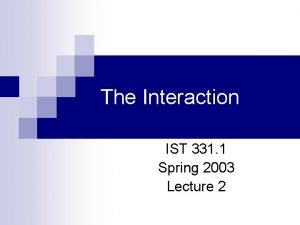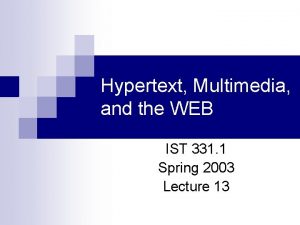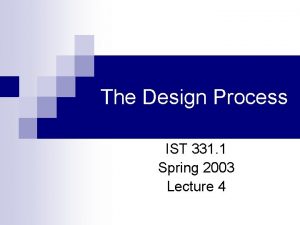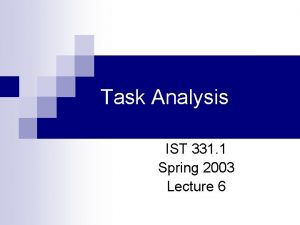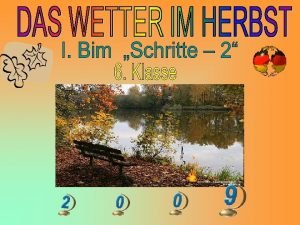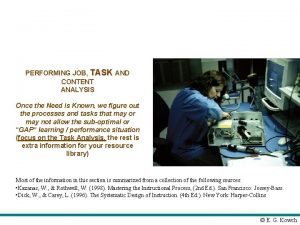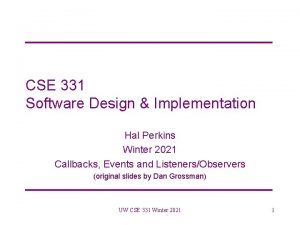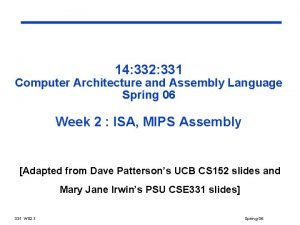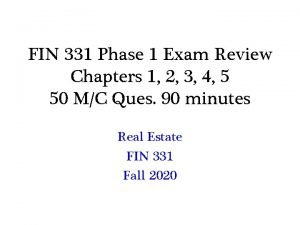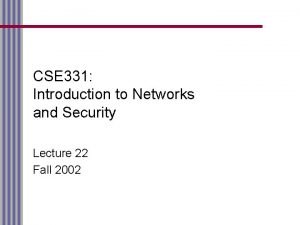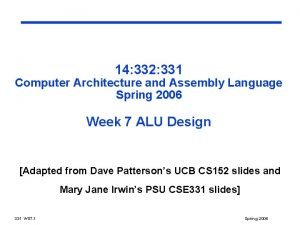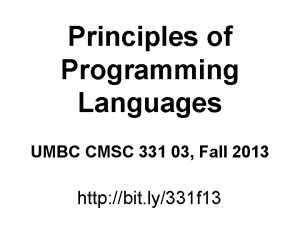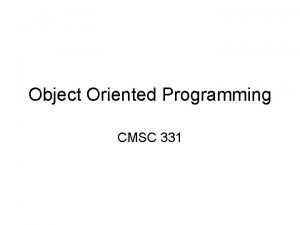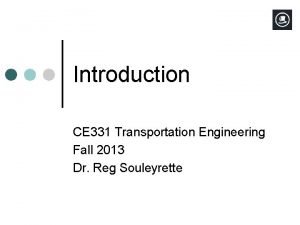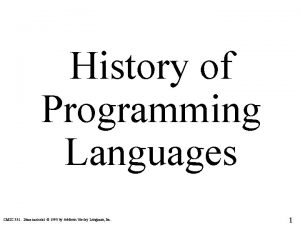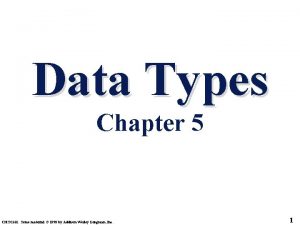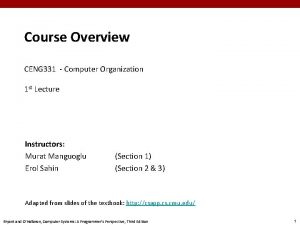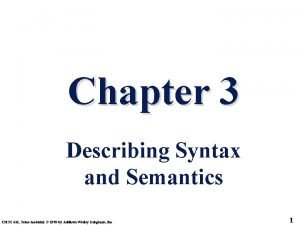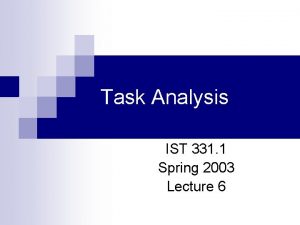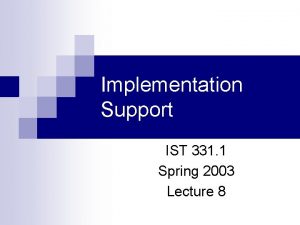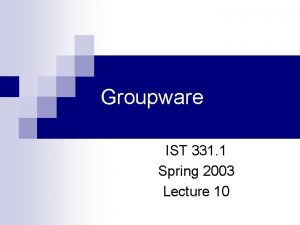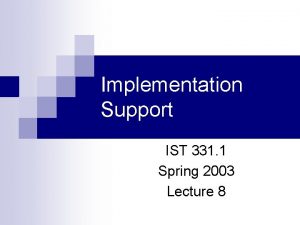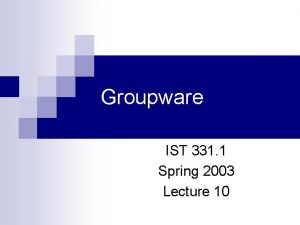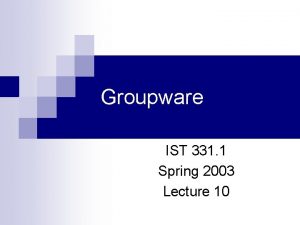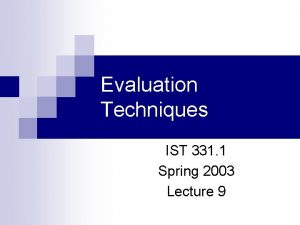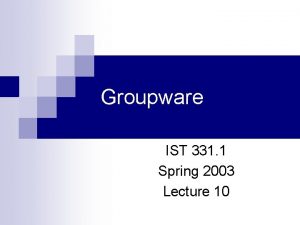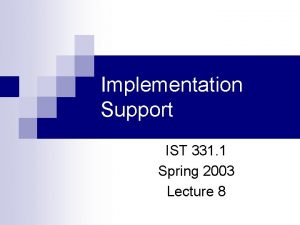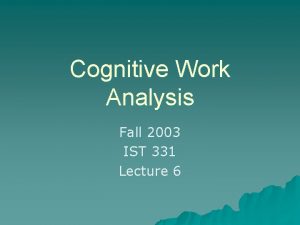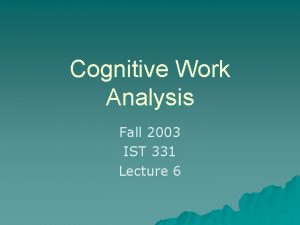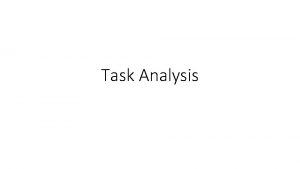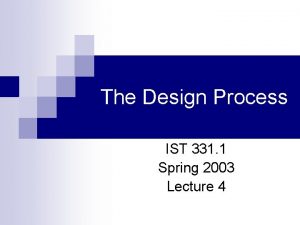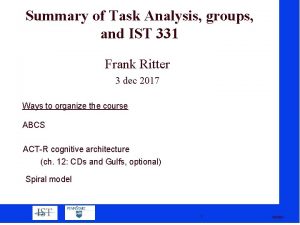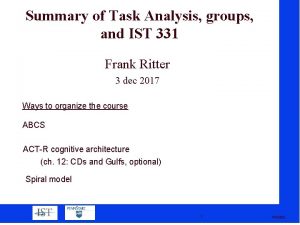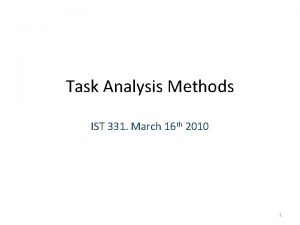Task Analysis IST 331 1 Spring 2003 Lecture




























- Slides: 28

Task Analysis IST 331. 1 Spring 2003 Lecture 6

What is Task Analysis? n Methods of analyzing people's jobs: ¨ what people do ¨ what things they work with ¨ what they must know

An Example n in order to clean the house n n n get the vacuum cleaner out fix the appropriate attachments clean the rooms when the dust bag gets full, empty it put the vacuum cleaner and tools away must know about: n vacuum cleaners, their attachments, dust bags, cupboards, rooms etc.

Approaches to task analysis n Task decomposition splitting task into ordered subtasks n Knowledge based techniques what the user knows about the task and how it is organized n Entity-relation-based analysis relationships between objects, actions and the people who perform them General method: observe collect unstructured lists of words and actions organize using notation or diagrams n

Differences from other techniques Systems analysis vs. Task analysis system design - focus - the user Cognitive models vs. Task analysis internal mental state - focus - external actions practiced `unit' task - focus - whole job

Task Decomposition n Aims: describe the actions people do structure them within task subtask hierarchy describe order of subtasks n Focus on Hierarchical Task Analysis (HTA) text and diagrams to show hierarchy plans to describe order

Textual HTA Description Hierarchy description. . . 0. in order to clean the house 1. get the vacuum cleaner out 2. get the appropriate attachment 3. clean the rooms 3. 1. clean the hall 3. 2. clean the living rooms 3. 3. clean the bedrooms 4. empty the dust bag 5. put vacuum cleaner and attachments away. . . and plans Plan 0: do 1 - 2 - 3 - 5 in that order. when the dust bag gets full do 4 Plan 3: do any of 3. 1, 3. 2 or 3. 3 in any order depending on which rooms need cleaning N. B. only the plans denote order

Generating the Hierarchy get list of tasks group tasks into higher level tasks decompose lowest level tasks further Stopping rules - How do we know when to stop? Is “empty the dust bag” simple enough? Purpose: expand only relevant tasks Motor actions: lowest sensible level

Diagrammatic HTA

Refining the Description Given initial HTA (textual or diagram) How to check/improve it? Some heuristics: paired actions e. g. , where is `turn on gas' restructure e. g. , generate task `make pot' balance e. g. , is `pour tea' simpler than making pot? generalize e. g. , make one cup or two …. . or more

Refined HTA for making tea

Types of Plan fixed sequence - 1. 1 then 1. 2 then 1. 3 optional tasks - if the pot is full 2 waiting for events - when kettle boils 1. 4 cycles - do 5. 1 5. 2 while there are still empty cups time-sharing - do 1; at the same time. . . discretionary - do any of 3. 1, 3. 2 or 3. 3 in any order mixtures - most plans involve several of the above

Knowledge Based Analyses Focus on: Objects - used in task Actions - performed Taxonomies represent levels of abstraction

Knowledge Based Analyses - Example motor controls steering wheel, indicators engine/speed direct ignition, accelerator, foot brake gearing clutch, gear stick lights external headlights, hazard lights internal courtesy light wash/wipers front wipers, rear wipers washers front washers, rear washers heating temperature control, air direction, fan, rear screen heater parking hand brake, door lock radio numerous!

Task Description Hierarchy Notation TDH - Task Description Hierarchy Three types of branch point in taxonomy: XOR - normal taxonomy - object in one and only one branch AND - object must be in both - multiple classifications OR - weakest case - can be in one, many or none wash/wipe AND function XOR wipe wash position XOR front rear front wipers, rear wipers front washers, rear washers front wipers, front washers rear wipers, rear washers

Entity-Relationship Based Techniques • Focus on objects, actions and their relationships • Similar to OO analysis, but includes non-computer entities • Emphasizes domain understanding not implementation • Running example: `Vera's Veggies' - a market gardening firm owner/manager: Vera Bradshaw employees: Sam Gummage and Tony Peagreen various tools including a tractor `Fergie‘ two fields and a glasshouse new computer controlled irrigation system

Objects Start with list of objects and classify them: Concrete objects: simple things: spade, plough, glasshouse Actors: human actors: Vera, Sam, Tony, the customers what about the irrigation controller?

Objects (Cont’d) Composite objects: sets: the team = Vera, Sam, Tony tuples: tractor may be < Fergie, plough > To the objects add attributes: Object Pump 3 simple - irrigation pump Attributes of each object: status: on/off/faulty capacity: 100 liters/minute Need not be computationally complete

Actions List actions and associate with each: agent - who performs the actions patient - which is changed by the action instrument - used to perform action Examples: Sam (agent) planted (action) the leeks (patient) Tony dug the field with the spade (instrument)

Actions (cont’d) Note: • implicit agents - read behind the words `the field was ploughed' - by whom? • indirect agency - the real agent? `Vera programmed the controller to irrigate the field' • messages - a special sort of action `Vera told Sam to. . . ' • rôles - an agent acts in several rôles Vera as worker or as manager

E/R Example I - objects and actions Object Sam human actor Actions: S 1: drive tractor S 2: dig the carrots Object Vera human actor | the proprietor Actions: as worker V 1: plant marrow seed V 2: program irrigation controller Actions: as manager V 3: tell Sam to dig the carrots Object the men composite Comprises: Sam, Tony Object glasshouse simple Attribute: humidity: 0 -100% Object Irrigation Controller non-human actor Actions: IC 1: turn on Pump 1 IC 2: turn on Pump 2 IC 3: turn on Pump 3 Object Marrow simple Actions: M 1: germinate M 2: grow

Events are when something happens • performance of action `Sam dug the carrots‘ • spontaneous events `the marrow seed germinated‘ `the humidity drops below 25%‘ • timed events `at midnight the controller turns on’

Relationships • object-object social - Sam is subordinate to Vera spatial - pump 3 is in the glasshouse • action-object agent (listed with object) • patient and instrument • actions and events • temporal and causal `Sam digs the carrots because Vera told him' • temporal relations also use HTA or dialogue notations. show task sequence (normal HTA) show object lifecycle

E/R example II - events and relations Events Ev 1: humidity drops below 25% Ev 2: midnight Relations: object-object location ( Pump 3, glasshouse ) location ( Pump 1, Parker's Patch ) Relations: action-object patient ( V 3, Sam ) - Vera tells Sam to dig patient ( S 2, the carrots ) - Sam digs the carrots. . . instrument ( S 2, spade ) -. . . with the spade Relations: action-event before ( V 1, M 1 ) - the marrow must be sown before it can germinate triggers ( Ev 1, IC 3 ) - when humidity drops below 25%, the controller turns on pump 3 causes ( V 2, IC 1 ) - the controller turns on the pump because Vera programmed it

Sources of Information Documentation manuals say what is supposed to happen but, good for key words and prompting interviews Observation formal/informal, laboratory/field Interviews the expert: manager or worker? (ask both!)

Early analysis Extraction from transcripts list nouns (objects) and verbs (actions) beware technical language and context: `the rain poured’ vs. `I poured the tea’ Sorting and classifying grouping or arranging words on cards ranking objects/actions for task relevance use commercial outliner Iterative process: data sources analysis But costly, so use cheap sources where available

Uses of Task Analysis Manuals and Documentation Conceptual Manual • from knowledge entity relations based analysis • good for open ended tasks Procedural ‘How to do it’ Manual • from HTA description • good for novices To make cups of tea • assumes all tasks known Make pot of tea once water has boiled boil water –– see page 2 empty pot make pot –– see page 3 wait 4 or 5 minutes pour tea –– see page 4 warm pot put tea leaves in pot pour in boiling water –– page 1 –– –– page 3 ––

Other Uses of Task Analysis Requirements capture and systems design • lifts focus from system to use • suggests candidates for automation • uncovers user's conceptual model Detailed interface design • taxonomies suggest menu layout • object/action lists suggest interface objects • task frequency guides default choices • existing task sequences guide dialogue design NOTE. task analysis is never complete rigid task based design inflexible system
 Bae yong-kyun
Bae yong-kyun Ist 331
Ist 331 Ist 331
Ist 331 Ist spring design and validation
Ist spring design and validation 01:640:244 lecture notes - lecture 15: plat, idah, farad
01:640:244 lecture notes - lecture 15: plat, idah, farad Why seasons
Why seasons Analysisist
Analysisist Winter kommt winter kommt flocken fallen nieder
Winter kommt winter kommt flocken fallen nieder Winter kommt winter kommt flocken fallen nieder
Winter kommt winter kommt flocken fallen nieder Ich habe heute klassendienst
Ich habe heute klassendienst Es ist herbst bunte blätter fliegen
Es ist herbst bunte blätter fliegen Zu glauben ist schwer. nichts zu glauben ist unmöglich
Zu glauben ist schwer. nichts zu glauben ist unmöglich Content analysis and task analysis
Content analysis and task analysis Tiered task bias task
Tiered task bias task Ce 331
Ce 331 Ssis 331
Ssis 331 Uw cse 331
Uw cse 331 14:332:331
14:332:331 14:332:331
14:332:331 Fin 331 exam 1
Fin 331 exam 1 Cse 331
Cse 331 14:332:331
14:332:331 Umbc cmsc 331
Umbc cmsc 331 Cmsc 331
Cmsc 331 Ce 331
Ce 331 Cmsc 331
Cmsc 331 Cmsc 331
Cmsc 331 Ceng334
Ceng334 Cmsc 331
Cmsc 331

